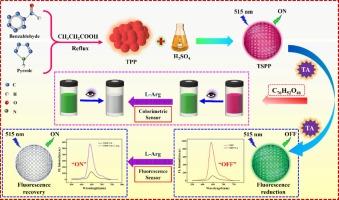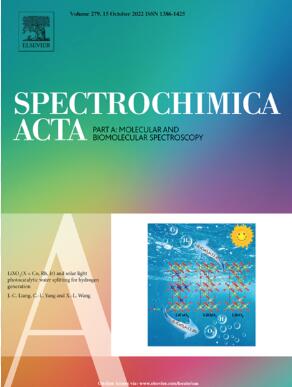Colorimetric and fluorescence dual-signal sensing of L-Arginine based on TSPP-TA
IF 4.3
2区 化学
Q1 SPECTROSCOPY
Spectrochimica Acta Part A: Molecular and Biomolecular Spectroscopy
Pub Date : 2024-11-29
DOI:10.1016/j.saa.2024.125505
引用次数: 0
Abstract
L-Arginine (L-Arg) is an essential basic amino acid for human growth and development. Several health disorders can be caused when the level of L-Arg is too high or weak in the body of a human being. Therefore, the quantification of L-Arg is great importance in the field of life sciences. Based on this, 5,10,15,20-(4-sulphonatophenyl)porphyrin (TSPP) probes with excellent water solubility and high quantum yield were synthesized by one-pot method. It was applied to colorimetric and fluorescence sensing systems. The maximum fluorescence emission wavelength was obtained at 643 nm when the excitation wavelength was set at 515 nm. The fluorescence signal was “ON” state with the purple-red of TSPP solution. The introduction of tannic acid (TA) into the TSPP solution partially converted TSPP to the double protonated form (H2TPPS4−). In the reaction, electron transfer taken place, leading to a decrease in the absorbance and fluorescence emission intensity of TSPP. This resulted in a color shift of the solution from purplish-red to green, effectively turning the fluorescence signal to an “OFF” state. The absorbance and fluorescence emission intensity of the quenched TSPP were significantly recovered due to the acid-base neutralization reaction occurs between alkaline L-Arg and TA when L-Arg was added to the TSPP-TA dual-signal sensing system. The color of the solution transitioned from green to colorless. Concurrently, the fluorescence signal was activated, marking an “ON” state. Therefore, an “ON-OFF-ON” type colorimetric and fluorescence dual-signal sensing system was constructed with TSPP-TA/L-Arg. The results showed that the linear range of L-Arg in the colorimetric sensing was 3.14 μM–145.20 μM with the detection limit (LOD, S/N = 3) of 0.11 μM. In the fluorescent sensing system, the linear range of L-Arg was 1.49 μM–271.74 μM with the detection limit (LOD, S/N = 3) of 0.07 μM. This dual-signal sensing system, which combined colorimetric and fluorescence indicators, has been effectively utilized for the high-precision and sensitive detection of L-Arg in real-world samples.

基于TSPP-TA的l-精氨酸比色和荧光双信号传感
l -精氨酸(L-Arg)是人体生长发育必需的基本氨基酸。当人体内的l -精氨酸水平过高或过低时,会引起几种健康疾病。因此,l -精氨酸的定量研究在生命科学领域具有重要意义。在此基础上,采用一锅法制备了具有优异水溶性和高量子产率的5,10,15,20-(4-磺酰基)卟啉(TSPP)探针。应用于比色和荧光传感系统。当激发波长为515 nm时,最大荧光发射波长为643 nm。荧光信号呈“开”状态,呈紫红色。在TSPP溶液中引入单宁酸(TA), TSPP部分转化为双质子化形式(H2TPPS4−)。在反应过程中发生电子转移,导致TSPP的吸光度和荧光发射强度下降。这导致溶液的颜色从紫红色转变为绿色,有效地将荧光信号转变为“关闭”状态。将L-Arg加入到TSPP-TA双信号传感体系中,由于碱性L-Arg与TA发生酸碱中和反应,淬灭后的TSPP吸光度和荧光发射强度明显恢复。溶液的颜色由绿色变为无色。同时,荧光信号被激活,标记为“开”状态。因此,利用TSPP-TA/L-Arg构建了“ON-OFF-ON”型比色荧光双信号传感系统。结果表明:L-Arg在比色检测中的线性范围为3.14 μM - 145.20 μM,检出限(LOD, S/N = 3)为0.11 μM;在荧光传感系统中,L-Arg的线性范围为1.49 μM - 271.74 μM,检出限(LOD, S/N = 3)为0.07 μM。该比色和荧光双信号传感系统已有效用于实际样品中l-精氨酸的高精度、灵敏检测。
本文章由计算机程序翻译,如有差异,请以英文原文为准。
求助全文
约1分钟内获得全文
求助全文
来源期刊
CiteScore
8.40
自引率
11.40%
发文量
1364
审稿时长
40 days
期刊介绍:
Spectrochimica Acta, Part A: Molecular and Biomolecular Spectroscopy (SAA) is an interdisciplinary journal which spans from basic to applied aspects of optical spectroscopy in chemistry, medicine, biology, and materials science.
The journal publishes original scientific papers that feature high-quality spectroscopic data and analysis. From the broad range of optical spectroscopies, the emphasis is on electronic, vibrational or rotational spectra of molecules, rather than on spectroscopy based on magnetic moments.
Criteria for publication in SAA are novelty, uniqueness, and outstanding quality. Routine applications of spectroscopic techniques and computational methods are not appropriate.
Topics of particular interest of Spectrochimica Acta Part A include, but are not limited to:
Spectroscopy and dynamics of bioanalytical, biomedical, environmental, and atmospheric sciences,
Novel experimental techniques or instrumentation for molecular spectroscopy,
Novel theoretical and computational methods,
Novel applications in photochemistry and photobiology,
Novel interpretational approaches as well as advances in data analysis based on electronic or vibrational spectroscopy.

 求助内容:
求助内容: 应助结果提醒方式:
应助结果提醒方式:


